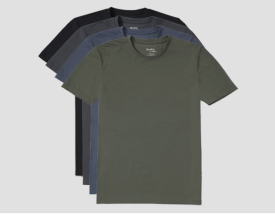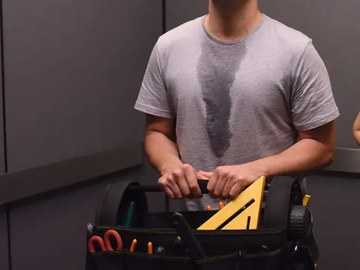Anyone who has powered through a workout, hiked a steep trail, or simply walked outside on a scorching day knows the misery of a sweat-soaked shirt. Cotton traps moisture, making you feel heavy, sticky, and chilled once the breeze hits. It is uncomfortable and can even lead to chafing.
That is where moisture-wicking fabrics step in. These high-tech textiles do not just sit back and absorb sweat. They actively pull it away from your skin, spread it across the fabric’s surface, and let it evaporate fast. The result is clothes that stay lighter, drier, and far more comfortable.
But here is the real question: how much sweat can these fabrics actually handle before they give in? The answer depends on the fabric’s structure, fiber type, and how quickly it can transfer and release moisture.
Understanding Moisture-Wicking and Quick-Dry Fabrics
Before discussing how much sweat these fabrics can handle, it helps to clarify what the terms actually mean. Many people use “moisture-wicking” and “quick-dry” interchangeably, but they describe two related yet distinct functions. Moisture-wicking focuses on moving sweat away from your skin, while quick-dry emphasizes how fast that sweat disappears once it reaches the fabric’s surface. Together, they determine how comfortable and dry you stay when you start sweating hard.
What is Moisture-Wicking Fabric?
Moisture-wicking fabrics are engineered to pull sweat away from your skin and move it to the fabric’s outer surface, where it evaporates. Unlike cotton, which soaks up perspiration, these fabrics keep you drier and more comfortable.
The process works through capillary action. Just like water climbing up a paper towel, the tiny spaces between fibers act as channels that draw sweat outward. Adhesion (water molecules clinging to fibers) overpowers cohesion (water sticking to itself), moving moisture efficiently away from your skin.
What is Quick-Dry Fabric?
Quick-dry fabrics are built to release moisture rapidly. While wicking helps, these fabrics go further with breathable weaves and sometimes special coatings like durable water-repellent (DWR) finishes. These features let air pass through easily and cause water to bead and roll off the surface.
The result is clothes that dry up to 50% faster than cotton, keeping you light and comfortable during intense activity instead of stuck in damp, clingy gear.
The Science Behind the "Magic": How These Fabrics Are Made
Moisture-wicking and quick-drying fabrics depend on two key factors: capillary action to pull sweat along fibers and fabric structures that allow rapid evaporation. Manufacturers achieve this through several methods:
Chemical Finishes: Hydrophobic coatings prevent absorption, while hydrophilic finishes draw moisture outward. Some fabrics use both on different sides to move sweat in one direction. These treatments are cost-effective but may lose strength after repeated washes.
Plasma Treatments: Exposure to plasma gases alters fiber surfaces to attract or repel water. Like chemical finishes, the effect can diminish over time.
Fabric Design: Weaves, knits, and fiber blends influence airflow and absorption. For example, double-layer mesh with larger inner holes and tighter outer layers speeds evaporation.
Yarn Shape: Instead of round fibers, cross-shaped or flower-shaped yarns create microchannels that boost capillary action and move sweat outward.
Knitting Techniques: Special knitting patterns distribute sweat quickly across larger surface areas, preventing sticky buildup.
Finer Fibers: Slimmer fibers mean more fibers per yarn, increasing the number of sweat channels.
The most advanced performance fabrics combine several of these techniques to deliver durable moisture management that holds up wash after wash.
How Much Sweat Can Moisture-Wicking Fabrics Capture?
Moisture-wicking fabrics don’t hold large amounts of sweat the way cotton does. Instead, they manage it through constant transfer and evaporation. A single sweaty t-shirt can easily produce around 10 ml (0.3 oz) of sweat, and even more if someone sweats heavily.
Cotton absorbs and traps this moisture, staying wet for long periods. In contrast, synthetic fibers like polyester and nylon absorb very little, allowing sweat to be pulled to the fabric’s surface and evaporated quickly. This means the shirt feels lighter and drier even during intense activity.
The real advantage is not how much sweat these fabrics “capture,” but how effectively they move it away from the skin and release it into the air. By continuously wicking and drying, they can keep pace with significant sweat production and prevent the heavy, clammy feeling that comes with absorbent fabrics.
Benefits of Moisture-Wicking and Quick-Dry Fabrics
Stay Dry & Comfortable: Sweat is pulled away from the skin and evaporates quickly, preventing dampness, irritation, and chafing.
Temperature Control: Fast evaporation helps cool the body during activity and prevents post-workout chills by avoiding heavy, saturated fabric.
No Sweat Marks: Moisture moves outward and evaporates instead of forming visible stains.
Odor Reduction: Less moisture means fewer bacteria growth, keeping clothing fresher for longer.
Better Performance: Lightweight, dry clothing reduces distractions so you can move freely and focus on your activity.
Quick Drying: Fabrics dry much faster than cotton, reducing discomfort during long or hot sessions.
Durable: Strong synthetic fibers resist wear and repeated washing.
Versatile: Used in sportswear, workwear, travel gear, and everyday clothing.
Frequently Asked Questions
What makes moisture-wicking fabrics different from regular fabrics like cotton?
Moisture-wicking fabrics move sweat away from your skin and let it evaporate quickly, while cotton absorbs and holds sweat, making clothes feel heavy and damp.
How much sweat can a moisture-wicking shirt handle?
A shirt can manage around 10 ml (0.3 oz) of sweat or more, depending on how much you perspire. The key is not storage but the fabric’s ability to move and release sweat continuously.
Are quick-dry fabrics the same as moisture-wicking fabrics?
Not exactly. Moisture-wicking fabrics pull sweat away from your skin, while quick-dry fabrics are designed to evaporate that moisture faster. Many performance fabrics combine both.
Which fabrics are best for moisture-wicking?
Polyester, nylon, spandex blends, and merino wool are the most effective. They resist absorbing moisture and release sweat quickly.
What fabrics should I avoid if I want to stay dry?
Avoid 100% cotton, denim, rayon, and silk. These materials trap moisture and take much longer to dry.
How do I care for moisture-wicking and quick-dry clothing?
Wash in cold water with mild detergent, avoid fabric softeners, and air dry or tumble dry on low heat. Fabric softeners and high heat can reduce their wicking ability.
Are moisture-wicking clothes only for athletes?
No. They are also used in workwear, travel clothing, uniforms, and everyday apparel because of their comfort, quick-drying, and odor-fighting properties.
Capture Sweat, Feel Free
Moisture-wicking fabrics are not about storing sweat but about controlling it. By moving moisture away from the skin and accelerating evaporation, they help you stay dry, comfortable, and confident whether you are training, working, or on the go. Choosing the right fabric can make the difference between feeling weighed down and staying light and focused.
Ready to upgrade your gear? Shop At Neat.








